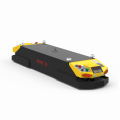Have you seen Terminator? That movie in which robots become self aware and decide to attack the human race? Last week representatives of over 100 robotics and artificial intelligence companies wrote an open letter to the United Nations. They are trying to stop robots like that coming to a city near you.
The problem is a serious one. As they write in the letter:
Lethal autonomous weapons threaten to become the third revolution in warfare. Once developed, they will permit armed conflict to be fought at a scale greater than ever, and at timescales faster than humans can comprehend… Once this Pandora’s box is opened, it will be hard to close.
In Terminator (and other movies on the subject) the robots and computer systems become self-aware. They ultimately decide that humans are the enemy, and start eliminating them. While this is science fiction at the moment, this could actually happen if weaponized robots with artificial intelligence are developed and humans lose control of them. Seems far-fetched?
Are you talking to me?
Facebook recently ran an experiment, where they let two AI enabled robots talk to each other. The two chat-bots, Alice and Bob, were programmed to speak English. Some time during the experiment they changed their language to make their communication more efficient. To the scientists monitoring the experiment the new language was gibberish. They were no longer able to follow the communication between the robots, so they were immediately shut down.
On this incident UK Robotics Professor Kevin Warwick told The Sun:
This is an incredibly important milestone, but anyone who thinks this is not dangerous has got their head in the sand. We do not know what these bots are saying. Once you have a bot that has the ability to do something physically, particularly military bots, this could be lethal… Smart devices right now have the ability to communicate and although we think we can monitor them, we have no way of knowing. Stephen Hawking and I have been warning against the dangers of deferring to Artificial Intelligence.
Pick Orders, Not Fights
I’m not saying robots are a bad thing. They can and should be used for good. To help and assist, not to destroy. It’s a good thing that logistics is all about helping and assisting 🙂
Below you will find an overview of different innovations where robotics is used in logistics processes:
Goods to Man Picking
Robots are already being used in many logistics operations and processes. One of the best known examples is probably the kiva robots Amazon is using in their warehouses to transport goods to picking stations, where human pickers can take the items they need from the cabinet, before the robot moves on. I shared a video on LogisticsMatter of these robots at work when Amazon bought the kiva company in 2012. At the beginning of this year Amazon had 45,000 robots operating in their warehouses. That number is still growing. Amazon is not the only company working on robots moving goods in the warehouse. Another example can be seen in the video below.
https://vimeo.com/182907241
Delivery
I recently had the opportunity to visit Washington DC. On the drive from the airport to my hotel, my Uber driver was pointing out some of the sites and talking about traffic and driving in the City. At one point we came across one of the Starship robots out on a delivery. It was patiently waiting for a car to pass before crossing the street. The first time I saw one out in the wild. I managed to snap a quick picture from the car.
And then there is this cool video from a delivery van concept designed by Mercedes:
https://youtu.be/ve63xdzc3hg
The mode of transport and the size actually doesn’t matter. Instead of a small robot or drone it can just as well be a semi truck, like OTTO’s moving a shipment of beer. Or what about entire ships, like Japan is planning for 2025. Goods can be moved by autonomously moving vehicles in a much more efficient way, than human controlled vehicles.
Cycle Counting
Cycle counting can be a hassle. Especially with goods high up in racking. Checking the content of a pallet at height can be both dangerous and time consuming. Several companies have developed solutions for using drones to take care of cycle counting. Some use the drones to film the locations and check the footage. Other work with RFID tags. Integration with WMS systems makes for easy reconciliation and resolving of issues. The video below shows the latter option.
Order Picking
Robots can also be used for order picking. It’s relatively easy to have a robot pick a single pallet or a box, but picking up a single item is much more complex. Robots are programmed, and if an object is placed randomly, all potential options for picking up the item need to be programmed into the robot. This is were Artificial Intelligence can be very useful. The robots can be trained to pick up items, by giving them the ability to learn from their actions. The robots can learn by trial and error and simply remember the correct way to pick up an item, whichever way it is facing.
It is a challenge many e-commerce and fulfillment players would like to see solved. Amazon has held a contest aimed at solving this problem.
One change Amazon has made to this year’s contest is to give the robots less space to work with than previous years. They now have to deal with objects right next to or on top of each other, as a human worker packing a bin of varied products into a box might. A bigger change is that half the objects a robot has to handle in a given round of the contest will only be revealed 30 minutes before it starts.
The winning team came from Australia. An interview with the team and shots of the robots in action:
Robot-enhanced warehouse workers
Robots can also be used to literally enhance human beings. One example can be seen in the video below. Using exoskeletons can help warehouse workers with lifting heavy items, but it can also enhance their endurance, by making assisting with moving around in general, making movement less tiring.
https://youtu.be/R9glwb38kWA
A simpler solution is being tested by DHL. In this case the workload for the warehouse worker is lighter, because he or she doesn’t have to push a picking cart. There is also no need to walk back and forth to a packing station and getting a new picking cart. The robot will take care of that. The productivity of the picker goes up this way
https://www.youtube.com/watch?v=255_5pfQ7-o
Overdrive Mode
Bachman Turner Overdrive Mode:
You ain’t seen nothin’ yet
B-b-b-baby, you just ain’t seen n-n-nothin’ yet
We’re just getting started. Just look at the range and speed of developments in robotics in the past years! We’re going into overdrive. Can’ t wait to see what’ s next!







